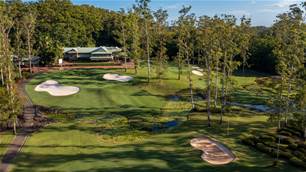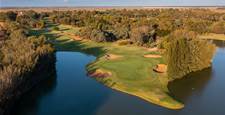Ask Mike Clayton what he thinks about the quality of golf to be found in Perth and he will get straight to the point.
“Had Alister MacKenzie visited Perth instead of Melbourne, we would have spent nearly a century now admiring its world-famous Sandbelt courses,” said Clayton, Golf Australia magazine’s Architecture Editor and one of this country’s foremost course designers. “There is sand everywhere and the rolling landscape is ideally made for golf.”
A fine example of what Clayton describes can be found at Sun City Country Club at Yanchep, a 50-minute drive north of Perth’s CBD.
“Like so much of the golf course land in and around Perth, Sun City is blessed with brilliant undulation and a bed of sand,” Clayton says.
But it’s only in recent times that its sandy base was exposed to become an integral part of playing the course.
Sun City first opened for play in July 1974 and was originally intended to be a part of an adjoining housing development planned by high-profile businessman Alan Bond.
But after nearly four decades the massive number of imported trees that lined most of the doglegging fairways had significantly changed the original characteristics of the course designed by Bob Green in collaboration with the club’s first captain, Murray Dawson.

The layout immediately proved popular after opening and hosted the West Australian PGA Championship for three years from 1975 to 1977.
Sun City gained a reputation for the quality of its greens, characterised by their subtle breaks and superb surfaces, and the demand the layout placed on accuracy with doglegs, left and right, on most holes. However, after nearly four decades the original tree plantings had started to suffocate the course as they had grown large and encroached onto many of the ideal playing lines. This was particularly penal on shorter hitters, who were forced to take a longer route to the green on many holes.
Nearly a decade ago, the club benefitted from the sale of land and entered into a joint venture with a developer, who planned to create a housing estate along the southern edge of the course. The club decided it was an ideal time to masterplan a redesign of the layout and the then design team of Geoff Ogilvy, Mike Clayton, Mike Cocking and Ashley Mead (OCCM) was commissioned.
The transformation of Sun City has been gradual but dramatic. The new green complexes are bigger and more interesting, as are the surrounds, while the natural bunkering and vast wasteland areas expose the sandy base that lies beneath.

Half of the course – three holes on the front nine, and the first six holes of the back nine – have been redesigned and offer most of the highlights of a round at Sun City. These holes were completed nearly six years ago and are easily distinguished from the untouched holes awaiting their transformation.
With the redesign work being funded by the developers of the adjoining residential estate, the next phase of Sun City’s improvement is yet to begin but, when it does, the layout will surge in the national ranking again.
“There is an opportunity to make noticeable improvements to all the remaining holes and once completed the members will be playing a course befitting the quality of the land,” Clayton says.
“As someone who has played on hundreds of different courses around the world, I can confidently say the best golf is played over and around hazards on the ground. In the past, much of the game played at Sun City was about hazards in the air.

“Bringing the focus back to ground level was the single most significant change reflected in the redevelopment of the new holes and has transformed the game played there.
The fact that Sun City ranked at No.81 in Golf Australia Magazine’s Top-100 Courses for 2022 – and No. 36 in the 2021 Top-100 Public Access Courses ranking – with only half of the course having been completed suggests our judges like what they have already seen at Yanchep.
“The course is blessed with gorgeous topography, sandy soil, a great locale, and lovely vegetation. If it were on the outskirts of an eastern seaboard city, Sun City would be packed seven days a week,” says Top-100 judge, Matt Mollica.
Fellow Top-100 judge Tristan Holmes was equally impressed.
“The ‘new’ holes remain a step above the originals and a full course of these more open, strategic holes would have Sun City on the verge of cracking a Top-50 spot in the ranking. Holes like the short par-4 2nd, and the back nine par-4s like the 10th and 13th are highlights of a round and are evidence of the potential this layout has,” Holmes said.
Holmes’ observations are right.
The diminutive 2nd is a cracker. Measuring just 275 metres from the tips, the hole plays slightly longer as the fairway – separated from the tee by a rugged, sandy wasteland gully – gradually climbs a gentle hill. Playing short of a scheme of bunkers to the right will leave a good line into any pin position, while a more aggressive play from the tee will leave a more difficult, precise second shot approach into the wide, angled green. It’s a wonderful risk and reward short par-4.
The redesigned holes offer a greater variety of shots and ask more questions of your game, more often during a round.
The 348-metre par-4 10th is the first of six consecutive ‘new’ holes and it’s a gem. Driver is not necessarily the go to club from the tee, with a lake and sandy wasteland left and a lone bunker to the right of the fairway. Skirting this fairway bunker is the ideal playing line into the angled green where most of the sandy trouble is left of your approach. Playing to the correct position for the flag of the day is a common theme of these redesigned holes.

A similar strategy is in play on the downhill par-4 13th. The 341-metre two-shotter asks plenty of questions as you stand on the tee. Bordered by wasteland to the right and a sandy gully cutting the fairway into two sections, players need to decide whether they will play long onto a tongue of fairway in the right half of the fairway, leaving a short approach to the green, which is angled diagonally back from left-to-right. The other option is to lay-up short of the gully and leave a longer, more difficult shot, from the left half of the fairway.
After being tested by a good uphill par-3 at the 14th, the par-5 15th begins the run of holes heading back toward the clubhouse. This 497-metre hole, in time, will become one of the highlights of a round at Sun City. A wide, inviting fairway is provided but the longer you hit your drive the narrower the landing area becomes with the massive expanse of sandy wasteland cutting in from the right edge of the rough, but this is only a problem for the longest of hitters. The fairway turns gently right and climbs gently for the green, which is again angled but this time diagonally back from right-to-left. A crop of three bunkers in a line to the left half of the green determines the easiest shot into the putting surface is from the right half of the fairway. It is a terrific par-5 with risk-and-reward elements that will see all types of numbers pencilled on scorecards here.
The changes have lifted a great course out of the ground, with the emphasis on strategy and making it playable for all clearly evident.
I am keen to see what is to come at Sun City once the remaining nine holes are transformed, hopefully along the same lines, by a yet to be determined course architect.
“There is an opportunity to make noticeable improvements to all the remaining holes and once completed the members will be playing a course befitting the quality of the land,” Clayton says. “The next phase of the work will make for a more coherent course.”
And, according to Clayton, a fully redesigned Sun City could be the start of something even bigger for Australian golf.
“If anyone had the will to build golf in the fashion of Tasmania’s world-class foray into public golf, Western Australia could have a bunch of incredible golf courses such is the quality of the coastal land running north from Sun City,” he said.
 FACT FILE
FACT FILE
ADDRESS: St Andrews Drive, Yanchep, Western Australia
CONTACT: (08) 9561 1148
WEBSITE: www.suncitycountryclub.com.au
DESIGNERS: Bob Green and Murray Dawson (1974); Geoff Ogilvy, Mike Clayton, Mike Cocking and Ashley Mead – OCCM (2016).
COURSE SUPERINTENDENT: Craig Hamilton.
 PGA PROFESSIONAL: Jim Danas.
PGA PROFESSIONAL: Jim Danas.
GREEN FEES: $45 (18 holes, weekdays), $58 (Sunday).
MEMBERSHIP: Sun City has a host of options from seven-day membership ($2,200 annual subscription) through to a Pay As You Play membership for just $300 where the green fee is paid for each round. Conditions apply. For more information, email Jessica at
events@suncitycountryclub.com.au or visit the club’s website.
ACCOLADES: Ranked No.81 in Golf Australia Magazine’s Top-100 Courses for 2022. Ranked No. 36 in Golf Australia Magazine’s Top-100 Public Access Courses for 2021.
Related Articles

Course Review: Cape Kidnappers

Review: Bonville Golf Resort












